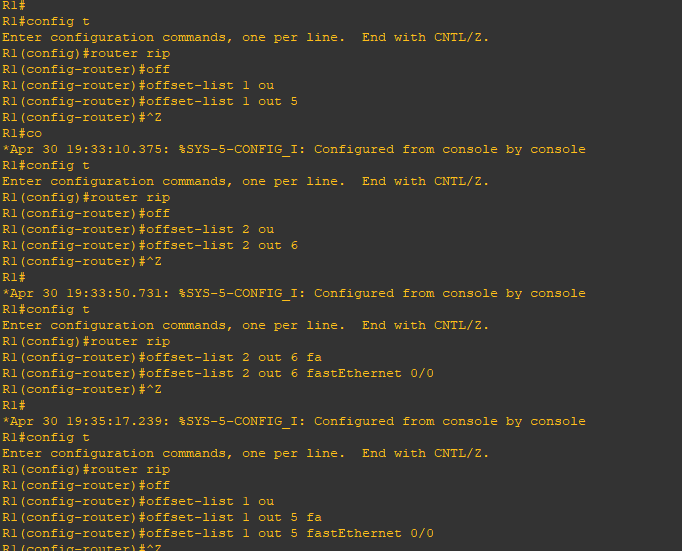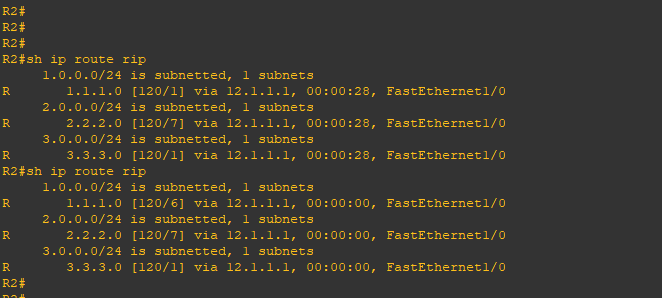This topic is to discuss the following lesson:
Hey rene.
Could you explain, why would you use offset-list in a working network?
Hi Don,
The main reason to use it is for path control of distance vector routing protocols (RIP or EIGRP). If you have two links between routers then you could use an offset-list to increase the metric of 1 prefix, making it prefer the other link.
For outbound traffic I wouldn’t use the offset-list, you can use policy based routing for this (it has more options). An offset-list might be useful for inbound traffic perhaps…for example, let’s say that you have a router with two links connected to another router that is out of your control. You could use an offset-list to increase the metric for 1 prefix so that the router on the other side prefers the other link for this particular prefix. This allows you to have “path control” even without access to the other router.
Rene
You applied off-set list to 1.1.1.1 and 11.11.11.11. The result – R2 show ip route rip – 1.1.1.1 has a new hop count of 6 and 11.11.11.11 has new hop count of 11. What if we had a R3 connected to R2… would it show 1.1.1.1 [120/7] and 11.11.11.11 [120/12]. Does R3 take into account the off-set list between R1 and R-2? Does that off-set promulgate throughout the network?
Hi Jason,
That’s correct. R1 is advertising these networks with a certain hop count to R2 so that’s what R2 is installing in its routing table.
When it’s advertising these prefixes to R3, it will advertise the metric that it has stored for these networks.
Rene
How would the offset work for eigrp since it doesnt use hopcount.
Abdool,
Good question! If you lab up offset lists with EIGRP you will discover that whatever value you enter as the offset will be added to the composite metric of EIGRP. As you may know, the composite metric of EIGRP is the result of a complex formula, but by default, it is a result of Bandwidth and Delay values. Fortunately, Cisco is smart enough to know that it is best not to mess with bandwidth values for the purpose of EIGRP traffic engineering (because this can mess up things like QoS).
So what you will see is that the Delay used to calculate the Composite Metric will be manipulated such that the final Composite Metric will increase to include your offset list value.
Hi, lads!
The offset list works only with standard ACL, not extended? With reference to EIGRP?
Thanx!
Hello Sergei
The offset does not work with extended access lists. This is because the offset list modifies or increases the metric of a network prefix. When used, the access list determines the network prefixes that should be modified. Only the network prefix is necessary and thus only a standard access list would be used. A source and destination IP address would be meaningless in such a situation, so extended access lists are not used.
I hope this has been helpful!
Laz
Hi Laz ,
Would u please explain with diagram how inbound offset is used for path control if a router has two link connected to another router ?
How inbound offset picture comes into play and prefer the other link by increase the metric .
please share with topology for better understand .
And last one please explain this command , i don’t understand it
R2(config)#access-list 2 permit 11.11.11.0 0.0.0.255
Kindly confirm :-
Is they choose high metric route only to in routing table if metric >1 ( Multiple Link )
Regards
chahal
Hello Shivam
Take a look at the following diagram:
Imagine you have control over R1 but R2 belongs to another organization. You want to configure RIP so that incoming traffic to the 1.1.10/24 network will prefer the Fe0/0 interface instead of the Fe0/1 interface. You can configure the following:
R1(config)#router rip
R1(config-router)#offset-list 1 out 5 fastethernet 0/1
You see that you can indicate the exit interface via which the offset list will be applied. Now don’t confuse inbound traffic with the out keyword. The out keyword refers to the direction of the RIP update (out of the Fe0/1 interface of R1) and not the direction of the traffic, which is inbound.
This is simply a creation of a second access list that will match the prefix 11.11.11.0/24 (the other loopback of R1) in order to apply a second offset list in R2.
I hope this has been helpful!
Laz
Hi Laz ,
How can we identify the direction of incoming and outgoing traffic for a particular prefix and what is the direction of prefix irrespect to traffic ???
Kindly share in brief with flow of traffic with prefix.
What is the difference bw packet flow and one flow ??
Please share brief explanation with multiple topology flow diagram for better understanding.
Rgds.
Shivam Chahal
Hello Shivam
Take a look at the diagram again:
We want to make traffic that is destined for 1.1.1.0/24 that is routed by R2 towards R1 to prefer the link over the Fe0/0 interface. As far as the direction of user traffic goes, from the point of view of R1, this is inbound traffic.
The offset-list configuration that is applied to R1 is the following:
R1(config)#router rip
R1(config-router)#offset-list 1 out 5 fastethernet 0/1
Here the out keyword refers to the direction of the RIP update. So R1 sends a RIP update for the 1.1.1.0/24 network to R1, that is, outbound.
I’m not sure what you mean here. Can you explain what you mean by “one flow”?
I hope this has been helpful!
Laz
Sorry ,
It was per flow , I read it from Google .![]()
Hi Laz ,
I have configured three loop-back on Router R1 (1.1.1.0, 2.2.2.0 & 3.3.3.0 on /24 Subnet Mask) and after that i want to change the hop count of all the loop back on R1 (outbound interface ) .I applied three offset list (1,2&3) respectively.i want to change the hop count for L0 as 5 ,L1 as 6 & L2 as 7 .
My concern is how many offset list apply if i want to change different hop count for different prefixes .
How many offset list call by rip at same time if we set different hop count for all the loop back ?
Noted :-After configuring the offset on all loop back and check the output on R2 they reflect or change the metric only for one prefix at a same time .
Rgds’
Shivam
Hello Shivam
I went in and labbed this up as well. It seems that RIP allows only one offset list to be configured for each direction. So you can have one inbound and one outbound offset list. Any changes to the offset list, and the previous offset list is removed and replaced with the new one.
One thing you can do is to include all of the loopback subnets within the same access list, and increase the hop count of all of the subnets simultaneously. Unfortunately you cannot assign a different hop count to different prefixes this way. The same limitations exists for offset lists for EIGRP as well.
I hope this has been helpful!
Laz
Hi Laz ,
Thanks for the reply , the above you mentioned is the limitation of rip , same is configured by me .
What happen if we have don"t have access of other router then how can i give offset list on inbound interface ?
Please confirm what router behave if we have interface more than one like it is directly connected to R3 (two Wan Link ) so i think there is no need to configure offset list on inbound interface of any one of router .kindly share your view in this please .
Rgds
Shivam Chahal
Hi Rene /Laz ,
This is a highlighted and important question which i want to clear regarding traffic direction with prefix .
Please share a detailed description on below points with suitable example
) How can we identify the direction of traffic with prefix :i.e which one is incoming traffic and outgoing traffic respect to prefix because in firewall we block the specific traffic , how can we identify it that the traffic which firewall receive from a particular prefix is incoming or outgoing .
Please i am not asked the inbound or outbound direction as it is cleared understood by reading your previous post , i am asked about the traffic respect to prefix .
)In offset list , we filter incoming traffic or outgoing traffic ?
Please share explanation in detail with example .
Regards
Shivam Chahal
Hello Shivam
If you only have access to one router, then the only thing you can do is to configure outbound offset-lists to influence the routing on the other router. You cannot set the offset-list inbound on the other router.
When you have two connected routers, you can either configure an outbound offset-route on one router, or an inbound offset-route on the other router. If the parameters are the same, then the resulting routing is exactly the same.
The offset-list will not filter any traffic at all. It simply tells the router to change the metric by some value. The result is that the RIP routing will change. How it changes can be seen in the routing table in each router. By looking at the routing table, you will then be able to determine how traffic patterns will change.
I hope this has been helpful!
Laz
RENE Sir ,
iWANT TO KNOW FROM YOU , PLEASE EXPLAIN HOW CAN WE DECIDE THE INCOMING OR OUTGOING TRAFFIC WITH RESPECT TO PREFIX ?
Still this question is not clear do need full please ,Laz and Rene Sir Kindly support here .
sorry to post here again ![]()
Rgds
SHIVAM



